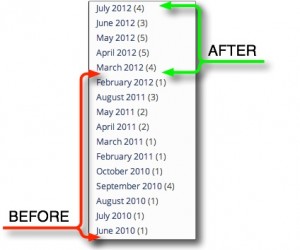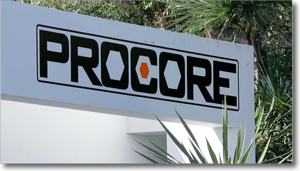Procore Technologies
 Procore provides cloud-based construction project management software. Founded in 2003 by Craig “Tooey” Courtemanche, to address the general-contractor market for homebuilders, the company has expanded to focus primarily on commercial contractors, who now constitute more than 90 percent of its client base. Procore—which is available in both English and Spanish—is being used to help streamline communication on thousands of projects by more than 400 different clients in the United States, Canada, and around the world, including general contractors, engineering firms, construction management firms, and specialty subcontractors. Procore was listed as an Inc. 5000 company in 2012.
Procore provides cloud-based construction project management software. Founded in 2003 by Craig “Tooey” Courtemanche, to address the general-contractor market for homebuilders, the company has expanded to focus primarily on commercial contractors, who now constitute more than 90 percent of its client base. Procore—which is available in both English and Spanish—is being used to help streamline communication on thousands of projects by more than 400 different clients in the United States, Canada, and around the world, including general contractors, engineering firms, construction management firms, and specialty subcontractors. Procore was listed as an Inc. 5000 company in 2012.
Early Attempts at Blogging
 For nearly five years prior to starting with Shortcut Blogging, the Procore team tried to blog. They really did try, because they felt it was important.
For nearly five years prior to starting with Shortcut Blogging, the Procore team tried to blog. They really did try, because they felt it was important.
“Blog articles are one of the easiest and most direct ways to create new website content and provide value to both our users and prospective clients, who can learn more about Procore the company, Procore the product, as well as get our viewpoint on the entire construction project management industry,” says Procore Technologies President Steve Zahm.
But they found it extremely difficult to keep it up consistently.
“The challenge was to create new blog articles consistently, on a regular schedule, without letting a lot of time lapse between articles,” Zahm recalls.
It was so tough to find time, in fact, that sometimes they’d go several months in a row without managing to create a single blog post.
“This despite the fact that creating additional content helped us rank higher in organic search for our specified search terms and provided prospective customers with a much better sense of who Procore is as a company,” Zahm notes.
It was simply a question of priorities.
“The requirement to do a 500- to 750-word blog post would always seem to get pushed to the bottom of our to-do list. It was something that was always viewed as ‘nice to have’ in terms of providing that content on our website, but never as ‘mission critical,’” he recalls.
How Blogging Became Easy
Once Procore began using Shortcut Blogging, however, it was a different story entirely. Except for a few holidays, not a week has gone by without a new blog post.
The two heads of the company, Zahm and Courtemanche, began the process by using the Shortcut Blogging brainstorming process.
“It really forced us to think about the topics,” Zahm recalls. “It was probably the most exciting part of getting started with Shortcut. Once we had established those topics, I would say it took us between four and six months until the blog posts really started to find a distinctive voice.”
What got Zahm’s attention at the outset was Shortcut Blogging’s time-saving solution to the blogging dilemma: interviewing the Procore team or its clients by Skype and/or phone and then turning those conversations into blog posts—and, later on, client case studies.
Shortcut Blogging “attacked the problem of coming up with topics and, really, by forcing the topics through the brainstorming session, you immediately provided value,” Zahm observes. “So as a new client, the time for Procore to realize value from your process and from your approach was very short, and we immediately saw the benefits.”
Following the initial brainstorming process, Zahm and Courtemanche did a series of phone interviews with one of Shortcut Blogging’s professional interviewers.
“Because of our interviewer’s background in radio, he really understood how to use conversational prompts and had a professional approach to moving through the interview and getting us to expand upon our comments, which, in turn, provided more content for our blog posts,” says Zahm. “I appreciate the fact that he took the time to get to know our company, to understand our product, and over the months that he worked with us, he really did come to understand the various features and benefits—not only as a standalone product, but also versus our competitors.”
An Easier Way to Produce Written Content
“One of the ways that we were also able to use his knowledge was to undertake to create a series of case studies with our customers. Our interviewer could take those same questions that he asked us during the blog-posting process and Shortcut used those to create written cases based upon our customers’ experiences.”
“For most busy professionals, such as the executive team at our company or the users at Procore client companies, people are used to making time for a phone call, but actually sitting down and typing is something that can take seven times as long as speaking. Having to sit down, come up with a proper sentence and paragraph structure—that is something that’s best accomplished by a professional editor,” Zahm believes.
“The Shortcut blogging approach seemed to make sense to me, because they were the first firm that I saw that didn’t just say, ‘Oh, you should blog.’ They said, ‘We’re going to make it simple, quick, and convenient for you to blog.’”
Shortcut’s use of trained professionals to do the interviewing—and specifically, the same person, who got to know the company and understand its product over time—set it apart from freelancers or offshore outfits, Zahm says.
“Because creating quality blog article content had been something that, as I mentioned, always fell to the bottom of my list,” says Zahm, “coming up with the topics was also a painful process. I believe that Shortcut Blogging’s approach to using the brainstorming process really removed one of my greatest concerns at the outset of our working together: How would we ever come up with enough topics to create quality content? Having seen how that process works, I went ahead and recommended the approach to several other companies we know of.”
“There were some growing pains at first in some of the quality of the editing,” Zahm admits. But he saw definite improvement. “And I think the consistency and the ability to adapt and improve the editing over time was also important for us,” he says.
The material created by Shortcut Blogging has served many functions. When Procore hired Daniel Cohen to be their new director of marketing, the blog posts set the standard he needed to aim for. But they also provided a body of work for him to study.
“He could not only learn more about Procore from those blog posts,” Zahm explains, “but it gave him a target to shoot for in terms of length, voice, choice of topics, etc.”
A Surprising Use for Procore’s Blog Content
 Not only does Procore use the content created by Shortcut Blogging for new hires, but the company also uses them for internal training. Non-customer facing employees at Procore don’t always understand the use cases or the business use of Procore. If someone is a software engineer, for example, they may not come into contact with clients as often as our sales representatives or our account managers do, so the case studies have become required reading for all our new employees so they get a feel for the impact Procore can have on our customers’ operations.
Not only does Procore use the content created by Shortcut Blogging for new hires, but the company also uses them for internal training. Non-customer facing employees at Procore don’t always understand the use cases or the business use of Procore. If someone is a software engineer, for example, they may not come into contact with clients as often as our sales representatives or our account managers do, so the case studies have become required reading for all our new employees so they get a feel for the impact Procore can have on our customers’ operations.
The company also incorporates the blog posts into their sales and marketing efforts. Whenever the Procore team has a new blog post, they automatically link to those blog posts from their Facebook page and Twitter feed, which means that those social media outlets have at least one post a week. The articles are also used by our sales representatives as examples of Procore’s market position or just general outlook on the different topics that we blog about.
“A weekly blog post is an opportunity for sales representatives to contact either customers that are in their sales pipeline or that they’re trying to nurture as potential prospects with something that may be of value, some information that helps educate that prospect or that potential customer,” Zahm notes.
“We try to view the blog posts as a consistent, reliable source of new content that can then be reused throughout the company, not only for internal employee training, but also for lead-nurturing efforts with prospective clients,” he says.
Removes The Pressure for Blogging
What’s more, the posts created by Shortcut Blogging also create a foundation for the Procore team to build upon—without all the pressure.
“Because those posts tend to be at least 500 to 750 words, it makes it easier for us to contribute additional short blog posts that may be smaller items but are easier for us to throw in,” Zahm notes. They may just be brief two- or three-paragraph posts on interesting things that are happening. “We can feel free to add additional materials to without having to feel that every new post has to be 500 words in length,” he says.
One of Procore’s key selling points is its team’s openness to feedback and its ability to adapt the Procore system to clients’ ever-evolving needs. Zahm found that kind of adaptability at Shortcut Blogging as well.
“It’s obvious to me that Shortcut Blogging makes a genuine effort to create quality content while at the same time accommodating some of the tactics and strategies needs to justify the cost of using Shortcut Blogging as a service,” he says. “For example, we have key organic search terms that we want to include in every written paragraph, and Shortcut Blogging is able to accommodate that and do so in a way that doesn’t seem tortuous or clumsy in any manner whatsoever. When we say we need to have those key search terms, those terms really appear—so I think that’s indicative of Shortcut Blogging’s ability to listen to their clients, adapt, and improve the process.”
The Case for Case Studies
 Case in point: client case studies. The Procore team wanted them, and tried without success to create them on their own. They asked their clients to create testimonial videos for them that they could then transcribe and use as case studies. It sounded simple enough.
Case in point: client case studies. The Procore team wanted them, and tried without success to create them on their own. They asked their clients to create testimonial videos for them that they could then transcribe and use as case studies. It sounded simple enough.
“We actually would ship them low-cost video cameras with a tripod and some suggested prompts for the script, all in an attempt to get them to just sit down and talk. It was a complete failure,” Zahm admits. “Without having an interview-type format, there was simply no way that these testimonials would get created. Our clients are extremely busy, they value their time above all else, and really, they can take time for a phone call, but they can’t really take time to actually sit down and type up their own comments. As a matter of fact, what seems to be the longest part of the case study process is getting final client approval—because nine times out of ten, they don’t even have time to read over the draft customer case study that we’ve created for them.”
After they had been using Shortcut Blogging for some time to create blog posts, the Procore team asked whether Shortcut could interview their clients to create Procore case studies. In the end, Shortcut came through, applying the same interview techniques to create the case studies. And they have proved very valuable.
“Case studies can end up being pieces of marketing collateral that have a very long shelf life. They have the ability to live on in our marketing website for months or even years,” Zahm explains.
“It includes photographs from the client’s construction project, photographs of the individual we’re talking to, and those become marketing pieces that can be distributed as PDFs. They can be located on our website and then downloaded by prospective clients. They really help build credibility for Procore.”
Approval at Every Level
The content of the case study ultimately has to be approved by the Procore client. “Sometimes we edit for clarity or flow, but we generally try to make the client look very successful, and we try to put the client’s decision-making process for choosing, implementing, and using Procore in the best light, so yes, they like to have that collateral. In turn, they can even use the Procore case study as a way to set their firm apart from competitors, because it shows that they have embraced cloud-based software, that they have a proven methodology and tool set for managing projects, and that they aren’t going to be doing things on a legal pad or on the back of an envelope. So our case studies actually become marketing pieces for our clients, too.”
Having worked with Shortcut Blogging for more than a year, Zahm has high praise for the content Shortcut produces. Now, he says, “you guys are the world’s best bloggers in the construction software market!”
Note: Our case studies are priced on a custom basis. ie…we need to talk to you. Here’s more information about Shortcut Case Studies.